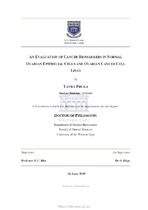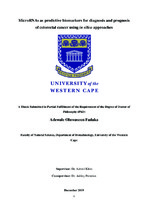| dc.description.abstract | Introduction: Globally, there are over 190,000 new reported cases of ovarian cancers per annum. This comprises 3% to 4% of all cancers in women. Ovarian cancer is one of the leading causes of deaths in women. Ovarian cancer is the second most diagnosed gynaecological malignancy and over all the fifth cause leading to death among all types of cancer in the UK in 2004. More than 70% of epithelial ovarian cancers are diagnosed at an advanced stage. Consequently, the prognosis is poor and the mortality rate high. Thus, the survival rate is affected by how far the disease has progressed or spread. A dire need exists to identify ovarian cancer biomarkers, which could be used as good indicators of expression in ovarian cancer cells in vitro
Aim: The aim of this study was to analyse selected cancer biomarkers, which are currently under intense investigation for their suitability to diagnose epithelial ovarian cancer at an early stage. These biomarkers were analysed in terms of their in vitro expression in normal epithelial cells and ovarian cancer cell lines, which allows for their genomic and proteomic classification. The expression analysis of each biomarker is related to the malignancy of a tumour and, therefore, advocates its use for potential future improvement of sensitive tumour markers.
Methods: The primary human ovarian surface epithelial cell line (HOSEpiC), SKOV-3 cells and the OAW42 human epithelial ovarian tumour cell lines were used to evaluate the selected cancer biomarkers. Cells were cultured using appropriate media and supplements, and real-time quantitative polymerase chain reaction (RT-PCR) utilized to validate expression levels of the following genes: HDAC1, HDAC2, HDCA3, HDAC5, HDAC6, HDAC7, HDAC8, LPAR1, LPAR2, MUC16 and FOSL1, against normal housekeeping genes GAPDH and HPRT. In addition, immunocytochemistry was also used in the validation process of the aforementioned genes.
Significance: ovarian cancer cells express gene signatures, which pose significant challenges for cancer drug development, therapeutics, prevention and management. The present study is an effort to explore ovarian cancer biomarkers to provide a better diagnostic method that may offer translational therapeutic possibilities to increase five- year survival rate.
Results: HDAC5, HDAC6, LPAR1, LPAR2 and MUC16 expressed distinctively in ovarian cancers matched to other tissues or cancer types have already been identified by RT-QPCR and confirmed by immunocytochemistry and efforts to generate monoclonal antibodies to the other six genes (HDAC1, HDAC2, HDAC3, HDAC7, HDAC8 and FOSL1) encoded proteins are underway.
Conclusions: here we provide strong evidence suggesting that HDAC5, HDAC6, LPAR1, LPAR2, except MUC16 are up regulated in ovarian cancer. These data were confirmed by examining Human Protein Atlas (HPA) databases, in addition to protein expression of HDAC5, HDAC6, LPAR1, LPAR2 and MUC16 in cells cytoplasm. For future prospective, using other techniques that assess the variant expression that could explain the release of these gene candidates into the circulation with serum tumour markers, and protein expression will be strengthened. | en_US |




